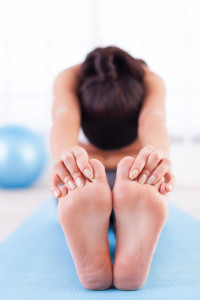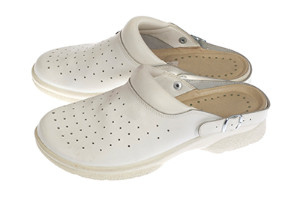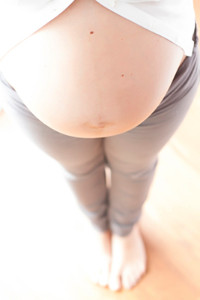Blog
Yoga and Plantar Fasciitis
 Plantar fasciitis, a common cause of heel pain, is caused by inflammation of the tissue in the bottom of the foot along the arch. Plantar fasciitis can actually be helped or worsened by yoga. Improper yoga form, which can cause the foot to become misaligned from a neutral position, can worsen already existing pain from plantar fasciitis. Meanwhile, stretching the foot and using proper form may help ease pain from plantar fasciitis. If you do plan to do yoga, it is important to keep the feet and knees aligned so that they do not pronate or supinate excessively when exercising. Pronation and supination is when the feet roll inwards or outwards. Orthotics may also help with pain and give your feet the support and cushioning they need. It is recommended to see a podiatrist if you are experiencing heel pain that does not go away. Furthermore, podiatrists will be able to analyze your gait and diagnose any pronation in your feet.
Plantar fasciitis, a common cause of heel pain, is caused by inflammation of the tissue in the bottom of the foot along the arch. Plantar fasciitis can actually be helped or worsened by yoga. Improper yoga form, which can cause the foot to become misaligned from a neutral position, can worsen already existing pain from plantar fasciitis. Meanwhile, stretching the foot and using proper form may help ease pain from plantar fasciitis. If you do plan to do yoga, it is important to keep the feet and knees aligned so that they do not pronate or supinate excessively when exercising. Pronation and supination is when the feet roll inwards or outwards. Orthotics may also help with pain and give your feet the support and cushioning they need. It is recommended to see a podiatrist if you are experiencing heel pain that does not go away. Furthermore, podiatrists will be able to analyze your gait and diagnose any pronation in your feet.
Plantar fasciitis can be very painful and inconvenient. If you are experiencing heel pain or symptoms of plantar fasciitis, contact Genine Befumo, DPM from University Foot and Ankle Center, L.L.C. Our doctor can provide the care you need to keep you pain-free and on your feet.
What Is Plantar Fasciitis?
Plantar fasciitis is the inflammation of the thick band of tissue that runs along the bottom of your foot, known as the plantar fascia, and causes mild to severe heel pain.
What Causes Plantar Fasciitis?
- Excessive running
- Non-supportive shoes
- Overpronation
- Repeated stretching and tearing of the plantar fascia
How Can It Be Treated?
- Conservative measures – anti-inflammatories, ice packs, stretching exercises, physical therapy, orthotic devices
- Shockwave therapy – sound waves are sent to the affected area to facilitate healing and are usually used for chronic cases of plantar fasciitis
- Surgery – usually only used as a last resort when all else fails. The plantar fascia can be surgically detached from the heel
While very treatable, plantar fasciitis is definitely not something that should be ignored. Especially in severe cases, speaking to your doctor right away is highly recommended to avoid complications and severe heel pain. Your podiatrist can work with you to provide the appropriate treatment options tailored to your condition.
If you have any questions please feel free to contact our office located in Monroe Township, NJ . We offer the newest diagnostic and treatment technologies for all your foot and ankle needs.
Yoga and Plantar Fasciitis
 Plantar fasciitis, a common cause of heel pain, is caused by inflammation of the tissue in the bottom of the foot along the arch. Plantar fasciitis can actually be helped or worsened by yoga. Improper yoga form, which can cause the foot to become misaligned from a neutral position, can worsen already existing pain from plantar fasciitis. Meanwhile, stretching the foot and using proper form may help ease pain from plantar fasciitis. If you do plan to do yoga, it is important to keep the feet and knees aligned so that they do not pronate or supinate excessively when exercising. Pronation and supination is when the feet roll inwards or outwards. Orthotics may also help with pain and give your feet the support and cushioning they need. It is recommended to see a podiatrist if you are experiencing heel pain that does not go away. Furthermore, podiatrists will be able to analyze your gait and diagnose any pronation in your feet.
Plantar fasciitis, a common cause of heel pain, is caused by inflammation of the tissue in the bottom of the foot along the arch. Plantar fasciitis can actually be helped or worsened by yoga. Improper yoga form, which can cause the foot to become misaligned from a neutral position, can worsen already existing pain from plantar fasciitis. Meanwhile, stretching the foot and using proper form may help ease pain from plantar fasciitis. If you do plan to do yoga, it is important to keep the feet and knees aligned so that they do not pronate or supinate excessively when exercising. Pronation and supination is when the feet roll inwards or outwards. Orthotics may also help with pain and give your feet the support and cushioning they need. It is recommended to see a podiatrist if you are experiencing heel pain that does not go away. Furthermore, podiatrists will be able to analyze your gait and diagnose any pronation in your feet.
Plantar fasciitis can be very painful and inconvenient. If you are experiencing heel pain or symptoms of plantar fasciitis, contact one of our podiatrists from University Foot and Ankle Center, L.L.C. Our doctors can provide the care you need to keep you pain-free and on your feet.
What Is Plantar Fasciitis?
Plantar fasciitis is the inflammation of the thick band of tissue that runs along the bottom of your foot, known as the plantar fascia, and causes mild to severe heel pain.
What Causes Plantar Fasciitis?
- Excessive running
- Non-supportive shoes
- Overpronation
- Repeated stretching and tearing of the plantar fascia
How Can It Be Treated?
- Conservative measures – anti-inflammatories, ice packs, stretching exercises, physical therapy, orthotic devices
- Shockwave therapy – sound waves are sent to the affected area to facilitate healing and are usually used for chronic cases of plantar fasciitis
- Surgery – usually only used as a last resort when all else fails. The plantar fascia can be surgically detached from the heel
While very treatable, plantar fasciitis is definitely not something that should be ignored. Especially in severe cases, speaking to your doctor right away is highly recommended to avoid complications and severe heel pain. Your podiatrist can work with you to provide the appropriate treatment options tailored to your condition.
If you have any questions please feel free to contact one of our offices located in East Brunswick and Monroe Township, NJ. We offer the newest diagnostic and treatment technologies for all your foot and ankle needs.
Read more about Plantar FasciitisRedskins DE Jonathan Allen Suffers Lisfranc Sprain
 Defensive end Jonathan Allen of the Washington Redskins sustained a Lisfranc sprain during the Redskins and San Francisco 49ers game. He is expected to miss about three to four weeks of the season. A Lisfranc injury occurs when the bones in the midfoot break or the ligaments are torn. Coach Jay Gruden spoke well of Allen and his skills. Allen was an All-American during his college career at Alabama. The Redskins beat the 49er’s 26 to 24.
Defensive end Jonathan Allen of the Washington Redskins sustained a Lisfranc sprain during the Redskins and San Francisco 49ers game. He is expected to miss about three to four weeks of the season. A Lisfranc injury occurs when the bones in the midfoot break or the ligaments are torn. Coach Jay Gruden spoke well of Allen and his skills. Allen was an All-American during his college career at Alabama. The Redskins beat the 49er’s 26 to 24.
Sports related foot and ankle injuries require proper treatment before players can go back to their regular routines. For more information, contact Genine Befumo, DPM of University Foot and Ankle Center, L.L.C. Our doctor can provide the care you need to keep you pain-free and on your feet.
Sports Related Foot and Ankle Injuries
Foot and ankle injuries are a common occurrence when it comes to athletes of any sport. While many athletes dismiss the initial aches and pains, the truth is that ignoring potential foot and ankle injuries can lead to serious problems. As athletes continue to place pressure and strain the area further, a mild injury can turn into something as serious as a rupture and may lead to a permanent disability. There are many factors that contribute to sports related foot and ankle injuries, which include failure to warm up properly, not providing support or wearing bad footwear. Common injuries and conditions athletes face, including:
- Plantar Fasciitis
- Plantar Fasciosis
- Achilles Tendinitis
- Achilles Tendon Rupture
- Ankle Sprains
Sports related injuries are commonly treated using the RICE method. This includes rest, applying ice to the injured area, compression and elevating the ankle. More serious sprains and injuries may require surgery, which could include arthroscopic and reconstructive surgery. Rehabilitation and therapy may also be required in order to get any recovering athlete to become fully functional again. Any unusual aches and pains an athlete sustains must be evaluated by a licensed, reputable medical professional.
If you have any questions please feel free to contact our office located in Monroe Township, NJ . We offer the newest diagnostic and treatment technologies for all your foot and ankle needs.
Redskins DE Jonathan Allen Suffers Lisfranc Sprain
 Defensive end Jonathan Allen of the Washington Redskins sustained a Lisfranc sprain during the Redskins and San Francisco 49ers game. He is expected to miss about three to four weeks of the season. A Lisfranc injury occurs when the bones in the midfoot break or the ligaments are torn. Coach Jay Gruden spoke well of Allen and his skills. Allen was an All-American during his college career at Alabama. The Redskins beat the 49er’s 26 to 24.
Defensive end Jonathan Allen of the Washington Redskins sustained a Lisfranc sprain during the Redskins and San Francisco 49ers game. He is expected to miss about three to four weeks of the season. A Lisfranc injury occurs when the bones in the midfoot break or the ligaments are torn. Coach Jay Gruden spoke well of Allen and his skills. Allen was an All-American during his college career at Alabama. The Redskins beat the 49er’s 26 to 24.
Sports related foot and ankle injuries require proper treatment before players can go back to their regular routines. For more information, contact one of our podiatrists of University Foot and Ankle Center, L.L.C. Our doctors can provide the care you need to keep you pain-free and on your feet.
Sports Related Foot and Ankle Injuries
Foot and ankle injuries are a common occurrence when it comes to athletes of any sport. While many athletes dismiss the initial aches and pains, the truth is that ignoring potential foot and ankle injuries can lead to serious problems. As athletes continue to place pressure and strain the area further, a mild injury can turn into something as serious as a rupture and may lead to a permanent disability. There are many factors that contribute to sports related foot and ankle injuries, which include failure to warm up properly, not providing support or wearing bad footwear. Common injuries and conditions athletes face, including:
- Plantar Fasciitis
- Plantar Fasciosis
- Achilles Tendinitis
- Achilles Tendon Rupture
- Ankle Sprains
Sports related injuries are commonly treated using the RICE method. This includes rest, applying ice to the injured area, compression and elevating the ankle. More serious sprains and injuries may require surgery, which could include arthroscopic and reconstructive surgery. Rehabilitation and therapy may also be required in order to get any recovering athlete to become fully functional again. Any unusual aches and pains an athlete sustains must be evaluated by a licensed, reputable medical professional.
If you have any questions please feel free to contact one of our offices located in East Brunswick and Monroe Township, NJ. We offer the newest diagnostic and treatment technologies for all your foot and ankle needs.
Read more about Sports Related Foot And Ankle InjuriesWhat to Look for in a New Pair of Shoes
 When it comes to shoe shopping, many people may feel overwhelmed by the amount of options available and what they should look for in a shoe. Here are some tips to find the right pair of shoes for you. First, don’t skimp out and buy a cheap pair of shoes; they tend to be of poor comfort and quality. While this doesn’t mean you necessarily need to spend more money, be warier of cheaper shoes. Remember that if you are wearing these shoes all day, buying a more expensive pair that provides top comfort and quality will ultimately be worth it. When you go to try on a new pair, go in the afternoon because feet swell during the day and are at their largest in the afternoon. A pair that fits well in the morning may not in the afternoon, so be on the lookout. Shoes should be snug, not too tight but not too loose. They should also provide wiggle room for the toes. Above all, shoes should be comfortable enough to wear for long periods of time; this is one of the most important tips you can follow.
When it comes to shoe shopping, many people may feel overwhelmed by the amount of options available and what they should look for in a shoe. Here are some tips to find the right pair of shoes for you. First, don’t skimp out and buy a cheap pair of shoes; they tend to be of poor comfort and quality. While this doesn’t mean you necessarily need to spend more money, be warier of cheaper shoes. Remember that if you are wearing these shoes all day, buying a more expensive pair that provides top comfort and quality will ultimately be worth it. When you go to try on a new pair, go in the afternoon because feet swell during the day and are at their largest in the afternoon. A pair that fits well in the morning may not in the afternoon, so be on the lookout. Shoes should be snug, not too tight but not too loose. They should also provide wiggle room for the toes. Above all, shoes should be comfortable enough to wear for long periods of time; this is one of the most important tips you can follow.
Getting the right shoe size is an important part of proper foot health. Seek the assistance of Genine Befumo, DPM from University Foot and Ankle Center, L.L.C. Our doctor will provide the care you need to keep you pain-free and on your feet.
Getting the Right Shoe Size
There are many people who wear shoes that are the incorrect size, negatively affecting their feet and posture. Selecting the right shoes is not a difficult process, so long as you keep several things in mind when it comes to choosing the right pair.
- When visiting the shoe store, use the tools available to measure your foot.
- Be sure there is ‘wiggle room’. There should be about an inch between your toes and the tip of your shoes.
- Do not always assume you are the same size, as manufacturers run differently.
- Purchase shoes later in the day, as your feet swell as the day progresses.
- If a shoe is not comfortable, it is not suitable. Most shoes can’t be ‘broken in’, and comfort should be the ultimate goal when it comes to choosing the right pair of shoes
As our feet hold our body weight and keep us moving, it is important to treat them right. Picking the right pair of shoes can provide your feet comfort and mobility without pain.
If you have any questions, please feel free to contact our office located in Monroe Township, NJ . We offer the newest diagnostic and treatment technologies for all your foot care needs.
Read more about Getting the Right Shoe Size: To Keep Your Feet HappyWhat to Look for in a New Pair of Shoes
 When it comes to shoe shopping, many people may feel overwhelmed by the amount of options available and what they should look for in a shoe. Here are some tips to find the right pair of shoes for you. First, don’t skimp out and buy a cheap pair of shoes; they tend to be of poor comfort and quality. While this doesn’t mean you necessarily need to spend more money, be warier of cheaper shoes. Remember that if you are wearing these shoes all day, buying a more expensive pair that provides top comfort and quality will ultimately be worth it. When you go to try on a new pair, go in the afternoon because feet swell during the day and are at their largest in the afternoon. A pair that fits well in the morning may not in the afternoon, so be on the lookout. Shoes should be snug, not too tight but not too loose. They should also provide wiggle room for the toes. Above all, shoes should be comfortable enough to wear for long periods of time; this is one of the most important tips you can follow.
When it comes to shoe shopping, many people may feel overwhelmed by the amount of options available and what they should look for in a shoe. Here are some tips to find the right pair of shoes for you. First, don’t skimp out and buy a cheap pair of shoes; they tend to be of poor comfort and quality. While this doesn’t mean you necessarily need to spend more money, be warier of cheaper shoes. Remember that if you are wearing these shoes all day, buying a more expensive pair that provides top comfort and quality will ultimately be worth it. When you go to try on a new pair, go in the afternoon because feet swell during the day and are at their largest in the afternoon. A pair that fits well in the morning may not in the afternoon, so be on the lookout. Shoes should be snug, not too tight but not too loose. They should also provide wiggle room for the toes. Above all, shoes should be comfortable enough to wear for long periods of time; this is one of the most important tips you can follow.
Getting the right shoe size is an important part of proper foot health. Seek the assistance of one of our podiatrists from University Foot and Ankle Center, L.L.C. Our doctors will provide the care you need to keep you pain-free and on your feet.
Getting the Right Shoe Size
There are many people who wear shoes that are the incorrect size, negatively affecting their feet and posture. Selecting the right shoes is not a difficult process, so long as you keep several things in mind when it comes to choosing the right pair.
- When visiting the shoe store, use the tools available to measure your foot.
- Be sure there is ‘wiggle room’. There should be about an inch between your toes and the tip of your shoes.
- Do not always assume you are the same size, as manufacturers run differently.
- Purchase shoes later in the day, as your feet swell as the day progresses.
- If a shoe is not comfortable, it is not suitable. Most shoes can’t be ‘broken in’, and comfort should be the ultimate goal when it comes to choosing the right pair of shoes
As our feet hold our body weight and keep us moving, it is important to treat them right. Picking the right pair of shoes can provide your feet comfort and mobility without pain.
If you have any questions, please feel free to contact one of our offices located in East Brunswick and Monroe Township, NJ. We offer the newest diagnostic and treatment technologies for all your foot care needs.
Read more about Getting the Right Shoe Size: To Keep Your Feet HappyPregnancy and Swollen Feet
 Swollen feet among pregnant women is a very common and normal condition. However, it can be very uncomfortable for women and should be monitored closely. The feet become swollen most often in the third trimester due to increased blood pressure and fluids in the lower body. The swelling tends to worsen during the day but can decrease or go away after a night of sleep. Sometimes, the swelling can spread to other parts of the body such as the thighs, hands and face. If the swelling spreads, it is important to see a doctor, as this could be a sign of potentially serious conditions. While you can’t get rid of swollen feet, consuming less salt, avoiding the consumption of too much liquid, and getting enough vitamins can help reduce the swelling. If your feet are swollen and are causing you pain, it is recommended to see a podiatrist for treatment.
Swollen feet among pregnant women is a very common and normal condition. However, it can be very uncomfortable for women and should be monitored closely. The feet become swollen most often in the third trimester due to increased blood pressure and fluids in the lower body. The swelling tends to worsen during the day but can decrease or go away after a night of sleep. Sometimes, the swelling can spread to other parts of the body such as the thighs, hands and face. If the swelling spreads, it is important to see a doctor, as this could be a sign of potentially serious conditions. While you can’t get rid of swollen feet, consuming less salt, avoiding the consumption of too much liquid, and getting enough vitamins can help reduce the swelling. If your feet are swollen and are causing you pain, it is recommended to see a podiatrist for treatment.
Pregnant women with swollen feet can be treated with a variety of different methods that are readily available. For more information about other cures for swollen feet during pregnancy, consult with Genine Befumo, DPM from University Foot and Ankle Center, L.L.C. Our doctor will attend to all of your foot and ankle needs.
What Foot Problems Can Arise During Pregnancy?
One problem that can occur is overpronation, which occurs when the arch of the foot flattens and tends to roll inward. This can cause pain and discomfort in your heels while you’re walking or even just standing up, trying to support your baby.
Another problem is edema, or swelling in the extremities. This often affects the feet during pregnancy but tends to occur in the later stages.
How Can I Keep My Feet Healthy During Pregnancy?
- Wearing orthotics can provide extra support for the feet and help distribute weight evenly
- Minimize the amount of time spent walking barefoot
- Wear shoes with good arch support
- Wear shoes that allow for good circulation to the feet
- Elevate feet if you experience swelling
- Massage your feet
- Get regular, light exercise, such as walking, to promote blood circulation to the feet
If you have any questions please feel free to contact our office located in Monroe Township, NJ . We offer the newest diagnostic and treatment technologies for all your foot and ankle needs.
Read more about Pregnancy and Foot HealthPregnancy and Swollen Feet
 Swollen feet among pregnant women is a very common and normal condition. However, it can be very uncomfortable for women and should be monitored closely. The feet become swollen most often in the third trimester due to increased blood pressure and fluids in the lower body. The swelling tends to worsen during the day but can decrease or go away after a night of sleep. Sometimes, the swelling can spread to other parts of the body such as the thighs, hands and face. If the swelling spreads, it is important to see a doctor, as this could be a sign of potentially serious conditions. While you can’t get rid of swollen feet, consuming less salt, avoiding the consumption of too much liquid, and getting enough vitamins can help reduce the swelling. If your feet are swollen and are causing you pain, it is recommended to see a podiatrist for treatment.
Swollen feet among pregnant women is a very common and normal condition. However, it can be very uncomfortable for women and should be monitored closely. The feet become swollen most often in the third trimester due to increased blood pressure and fluids in the lower body. The swelling tends to worsen during the day but can decrease or go away after a night of sleep. Sometimes, the swelling can spread to other parts of the body such as the thighs, hands and face. If the swelling spreads, it is important to see a doctor, as this could be a sign of potentially serious conditions. While you can’t get rid of swollen feet, consuming less salt, avoiding the consumption of too much liquid, and getting enough vitamins can help reduce the swelling. If your feet are swollen and are causing you pain, it is recommended to see a podiatrist for treatment.
Pregnant women with swollen feet can be treated with a variety of different methods that are readily available. For more information about other cures for swollen feet during pregnancy, consult with one of our podiatrists from University Foot and Ankle Center, L.L.C. Our doctors will attend to all of your foot and ankle needs.
What Foot Problems Can Arise During Pregnancy?
One problem that can occur is overpronation, which occurs when the arch of the foot flattens and tends to roll inward. This can cause pain and discomfort in your heels while you’re walking or even just standing up, trying to support your baby.
Another problem is edema, or swelling in the extremities. This often affects the feet during pregnancy but tends to occur in the later stages.
How Can I Keep My Feet Healthy During Pregnancy?
- Wearing orthotics can provide extra support for the feet and help distribute weight evenly
- Minimize the amount of time spent walking barefoot
- Wear shoes with good arch support
- Wear shoes that allow for good circulation to the feet
- Elevate feet if you experience swelling
- Massage your feet
- Get regular, light exercise, such as walking, to promote blood circulation to the feet
If you have any questions please feel free to contact one of our offices located in East Brunswick and Monroe Township, NJ. We offer the newest diagnostic and treatment technologies for all your foot and ankle needs.
Read more about Pregnancy and Foot HealthBlog Archives
- April 2024
- March 2024
- February 2024
- January 2024
- December 2023
- November 2023
- October 2023
- September 2023
- August 2023
- July 2023
- June 2023
- May 2023
- April 2023
- March 2023
- February 2023
- January 2023
- December 2022
- November 2022
- October 2022
- September 2022
- August 2022
- July 2022
- June 2022
- May 2022
- April 2022
- March 2022
- February 2022
- January 2022
- December 2021
- November 2021
- October 2021
- September 2021
- August 2021
- July 2021
- June 2021
- May 2021
- April 2021
- March 2021
- February 2021
- January 2021
- December 2020
- November 2020
- October 2020
- September 2020
- August 2020
- July 2020
- June 2020
- May 2020
- April 2020
- March 2020
- February 2020
- January 2020
- December 2019
- November 2019
- October 2019
- September 2019
- August 2019
- July 2019
- June 2019
- May 2019
- April 2019
- March 2019
- February 2019
- January 2019
- December 2018
- November 2018
- October 2018
- September 2018
- August 2018
- July 2018
- June 2018
- May 2018
- April 2018
- March 2018
- February 2018
- January 2018
- December 2017
- November 2017
- October 2017
- September 2017
- August 2017
- July 2017
- June 2017
- May 2017
- April 2017
- March 2017
- February 2017
- January 2017
- December 2016
- November 2016
- October 2016
- September 2016
- August 2016
- July 2016
- June 2016
- May 2016
- April 2016
- March 2016
- February 2016
- January 2016
- December 2015
- November 2015
- October 2015
- September 2015
- August 2015
- July 2015
- June 2015
- May 2015
- April 2015
- March 2015
- February 2015
- January 2015
- December 2014
- November 2014
- October 2014
- September 2014
- August 2014
- July 2014






